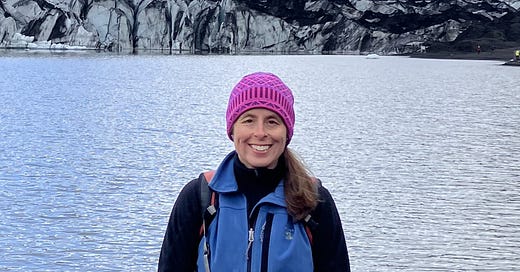As Iceland's giant glaciers melt, one researcher documents it all—and like a needle-in-a-haystack—finds hope
In Other News #14 // Celebrating the stories of everyday heroes among us.
Sarah Principato has visited Iceland at least 15 times since 1997. That’s when she began researching glaciers—large bodies of ice—in grad school.
Today, as a Gettysburg College professor of environmental studies of more than 20 years, she’s continuing her research by leading the next generation of scientists—her students—on her return trips.
Sarah Principato in Iceland. Photo courtesy Sarah Principato.
“We’re studying the land forms—the ridges or moraines the glaciers have left behind,” explains Principato. “Early on in my research, I studied a small ice cap in the northwest part of Iceland where we were dating those ridges or moraines. One thing we found is that the glaciers are rapidly melting today, much faster than before.”
Over the years, as she returns to some of the same sites, she can visibly see changes in the landscape.
“I’ve been to the edge of glaciers, and I’ve noticed how much further you have to hike now, because of how much melting has occurred,” she observes. “It’s obvious when you visit again and again.”
During the school year, Principato teaches earth system science, climate change and disasters, the geology of national parks, and an upper-level class on glaciers and records of climate change. But they’re much more than textbook subjects. She brings them alive, sharing first-hand knowledge with her students, both in the classroom and out in the field—even by taking them directly to Iceland’s glaciers.
“My students are heavily involved in the research,” Principato explains. “We’re looking at the variety of landforms—not just moraines, but drumlins, which are hills that form under glaciers. When you look at drumlins, you get a sense of the flow of the ice, and we’re trying to understand ice streams—the fast part of the glacier, because they could potentially raise the sea level rapidly.”
Principato is far from alone in her research. She references the documentary film “Chasing Ice,” with its stunning photography also documenting climate change’s impact.
Iceland, she explains, is important to the world’s climate system, because it’s positioned in the middle of ocean circulation features—on a boundary between cold and warm water.
Despite the icy and often somber subject matter, there’s also colorful Icelandic folklore that provides fascinating insights into Iceland’s pivitol location along this boundary.
“One of the fun things is that the name of one of the moraines is Skessugarður, which means ‘the wall between two trolls,’” says Principato. “What we see from that study, so far, is that that glacier rapidly collapsed at the end of the Ice Age. It could have implications as to how glaciers could collapse under climate change scenarios.”
What many people don’t realize, she says, is that what happens in Iceland has ripple effects across the globe.




